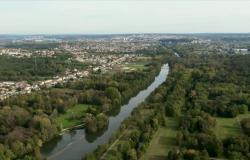The irradiated surface of Mars is a lost place.
And yet there may be shallow pools of water near the Martian surface, a place 1 000 times drier than the driest desert on the planet. NASA’s Mars Reconnaissance Orbiter – a satellite that has been orbiting Mars for nearly two decades – has spotted white material lining dry ravines on Mars. The space agency, which recently released the image below, suspects it is dusty water ice that could warm up and form puddles, similar to processes on our planet.
“Scientists believe that the dust particles in this ice act in the same way as dust that falls on Earth’s glaciers, warming in the sun and causing underground pockets of meltwater to form,” explained NASA.
“These pockets of water on our planet are often teeming with easy life, including algae, fungi and cyanobacteria,” the report explains. agency added. “Scientists believe similar shallow pools of water could exist on Mars and could also be excellent places to search for life on the Red Planet today. »
A NASA scientist viewed the first images of Voyager. What he saw gave him chills.
Such glacial dust on land glaciers creates phenomena called “cryoconite holes,” which can cover glaciers by the hundreds or more. One of them is shown in the second picture below.
Crushable speed of light
Although the Mars Reconnaissance Orbiter uses a giant camera capable of “seeing items as small as a table of dishes” from its orbit between 155 and 196 miles above the surface of space, it cannot detect any small pools. deep potential. But the picture clearly shows the white spots on the ravines of Mars in an area called Terra Sirenum. (The blue seen at the bottom of the gullies is coarse sand, a color not seen with the human eye but seen here in wavelengths of infrared light.)
The white areas show pockets of dusty water ice at the edges of Martian ravines, according to NASA.
Credit: NASA/JPL-Caltech/University of Arizona
A cryoconite hole on the Isunnguata Sermia glacier in Greenland.
Credit: Sean Gallup/Getty Photos
There are many ravines on Mars today, but they are not created by flowing water. Instead, planetary scientists suspect that freezing carbon dioxide seasonally changes from solid to gas (a process called sublimation) and provides “lubrication” for Martian soil and rocks to move downward. Blocks of ice could even slide down the walls of Martian craters or other terrain.
Mars, which has lost most of its insulating atmosphere, can no longer support much liquid water on its surface – but there could be water reserves deep down.
Planetary scientists recently used unprecedented data collected by the space agency’s InSight lander, which recorded geological activity on Mars for four years, to reveal that water could exist several kilometers deep in the Martian crust. The research, which calls for further investigation, could explain where the Red Planet’s water reserves have gone as the world dries up, and suggests Mars could be home to environments hospitable to life.
“We have identified the Martian equivalent of deep groundwater on Earth,” Michael Manga, a UC Berkeley planetary scientist who co-authored the new research, told Mashable.
For now, NASA’s car-sized rovers are exploring the remnants of Martian lakes and rivers in search of past habitability and potential evidence of Martian life – if it ever existed, that is. .






